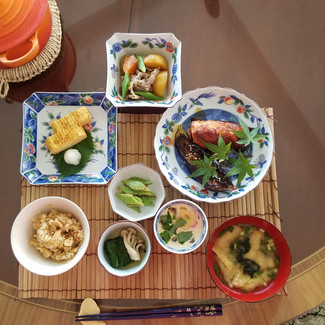A Summer of Food, Culture, and Self-Discovery
- caltechy
- Jan 28, 2019
- 3 min read
Thanks to the Studenski Fund and the Caltech Y, this past summer I traveled to Japan to study Japanese cuisine. I spent my days in Tokyo and Kyoto learning the nuances of each region’s cuisine and the meaning behind each ingredient.
After a long flight, I landed in Tokyo starving. As I took my first step off the plane, I had one goal in mind – to find something to eat. The trepidation that had been building completely disappeared when I took my first bite of the onigiri I unwrapped in my hands. I have found that food has the ability to completely calm nerves and bring about a sense of comfort, even in a foreign world.

A few days later, I started my first intensive cooking course in Tokyo and I immediately fell in love. I loved the idea that every ingredient and dish had its own purpose, such as adding a sprig of mitsuba to add color for a tamago dish or that neba neba dishes in the summer help prevent natsubate, or summer fatigue. Neba neba is food with a slimy and slippery texture prepared in a way to retain as much of the ingredients’ nutrient content as possible. The minimal cooking and the refreshing nature is ideal for the hot and humid months of summer. There was so much detail to cooking that I had never realized before. Even the order in which the ingredients are added to a recipe can make it easier to blend in ingredients. For Japanese cuisine, the order follows “sa, shi, su, se so” or sake (sweet), shio (salty), su (sour), shoyu (soy sauce), miso or sanota (others).
I have found that food has the ability to completely calm nerves and bring about a sense of comfort, even in a foreign world.
All too soon, my first course ended and I was off to Kyoto and away from the hectic bustle of Tokyo. I really appreciated the calmer atmosphere of Kyoto and I spent afternoons relaxing next to the river on a hot summer day. On one side, I would see a group of students learning a dance together and on the other, a family picnicking. There are subtle differences between the two cities and I was surprised to discover just as many differences in the cuisine. Kyoto is in the western region of Japan, or Kansai, and Tokyo the eastern region, or Kanto. The Kansai dishes I made, in general, were light and salty compared to the dark and strong flavors of the Kanto region. In Kyoto, I also learned how to prepare my own mackerel, starting from a fresh fish to sashimi. The need to cut with long smooth strokes rather than sawing motions remains ingrained in my mind. The first results in beautiful pieces of sashimi while the second results in mush.
Afterwards, I returned to Tokyo for a home cooking course. This course taught me how to incorporate Japanese cooking into my everyday life and the nature of cooking at home in Japan. My favorite recipe out of everything I made was the takoyaki in this course. I had takoyaki several times in Japan both in Kyoto and Tokyo but this recipe stood out among them all. Takoyaki is made of six key ingredients: flour, starch, dashi, egg, salt, and octopus. This recipe had the perfect ratio of each of these ingredients for a flavorful and perfectly chewy takoyaki. It seemed perfectly fitting that the last dish I learned was not only my favorite dish to eat in Japan but now also my favorite recipe to make.
I am very grateful to the Studenski Fund and the Caltech Y for giving me the opportunity to explore the world of cooking. During my time in Japan, I learned a lot about not only cooking, but also myself. Each day I felt excited to learn and it helped me realize that exploring what I love does not have to end here. Rather than let my degree define who I am, I will continue to explore and figure out exactly what I can do in the field of cooking, because what can I say - I loved every second of it!
The Studenski Memorial Award is a grant established in the memory of Paul Studenski, a Caltech student who was killed in an automobile accident while traveling across the United States in 1974. It is awarded to a Caltech undergraduate who has reached a crossroads in life and would benefit from a period away from the academic community to obtain a better understanding of self and to explore possible directions for the future.





















Comments